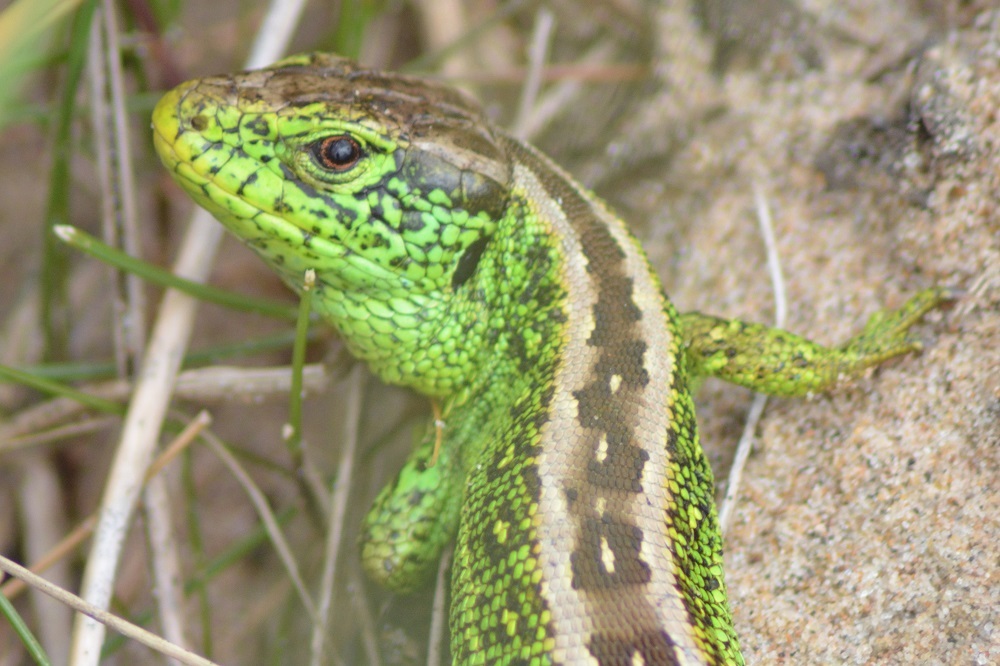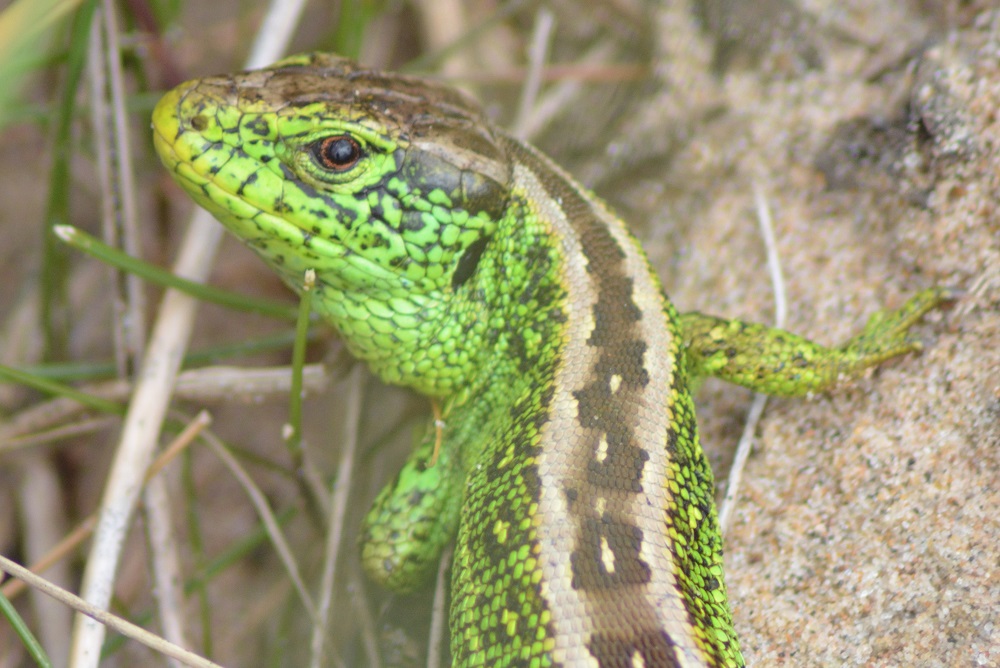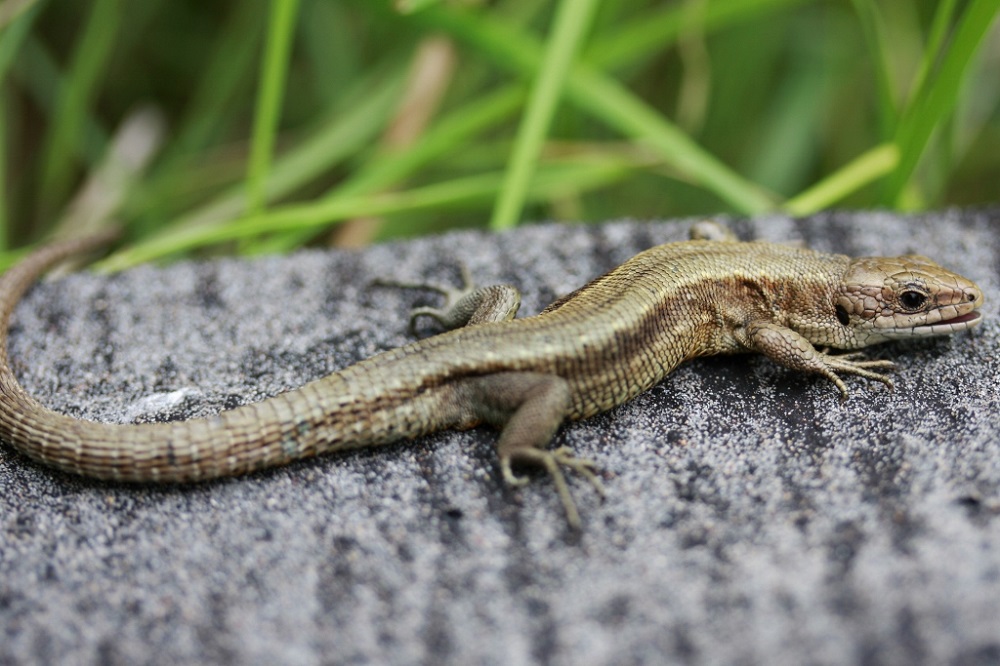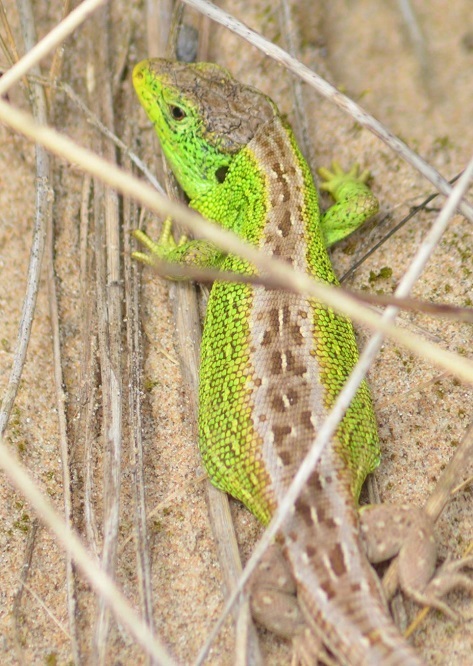Secrets of the Sand: Tawny Clark heads for the dunes on the trail of one of the UK’s rarest reptiles

Tawny Clark
Peter Hill isn’t a hard man to find. His van is a mobile vivarium. It literally slithers with images of amphibians and reptiles and it buoys me whenever I glimpse it out and about.
For me, the van is a call to arms. It reminds me that I must get back in the field. 2021 seems as suitably crazy a time as any to dust off my reptile boots and shake the cobwebs from my cerebellum. Although, when I arrive on site, there’s no sign of him.
Peter’s an extremely busy man. With a Wales-wide remit as Connecting the Dragons Officer at Amphibian and Reptile Conservation (ARC), he, and a small team of dedicated conservationists are responsible for delivering a diverse spectrum of surveying and monitoring, practical habitat management, public liaison, and acting as champions for this motley crew of species who are all too often overlooked in the battleground for conservation funding and who suffer unfairly in the ‘survival of the cutest’.
Alongside his role with ARC, Peter advises the likes of Natural Resources Wales, the Welsh Government and documentary filmmakers. Here in Wales, he’s the go-to guy for herpetofauna – the collective term for reptiles and amphibians. Originating from the Greek word herpeton meaning ‘creeping animal’ and not to be confused with herpes – which also derives from the Greek, to creep.
Diverse
Despite reptiles and amphibians belonging to distinct taxonomies, they have long been grouped together as ‘herps’ for their ectothermic similarity. Being labelled as ‘cold-blooded’ has done little to promote the appeal of these two wonderfully diverse classes of creeping creatures who both simply lack an internal system for regulating their body heat.
If anything, some herps demonstrate the opposite to cold-blooded personalities – frogs, toads and slow worms for instance make rather wonderful warm and cosy companions to us gardeners by eating slugs and snails. We should cherish these organic pest-controllers.
I’m not even sure what reptiles Peter has brought me to look for today, but it’s a good reason to get away from my desk and leave the house. This year, like many people, dressing out of pyjamas is a novelty, and I’m glad for the change.
My rucksack is weighed down with a thermal mug of tea, binoculars, notepad, pencils and a large water bottle. Good to go.
Thankfully, Peter arrives only minutes after I do. He wears a red bandana and carries only a single item – a camera with a huge telephoto lens. Pointing to my rucksack, he asks if I really want to lug it round. ‘We’re not going far.’
I’ve over-prepared and am already sweating in thick jeans as we head to the dunes. It’s 8am in early June and the sand is warming rapidly.
Basking spots
As we stalk across the maritime cake-walk ride and weave our way through the marram grass, we pause to look at suitable basking spots. Peter begins to impart some of his encyclopaedic knowledge, and I wish I had my notebook. It’s not a test; we’re here because he’s keen to show me some reptiles, but still, it’d be nice if my brain could keep up.
When Peter talks of marram grass it takes me back to university field trips. In those days, I was too busy goofing around and revelling in the freedoms of student life to pay much attention and the fundamental environmental concepts I studied feel like they belong to a past, practically forgotten, self. It’s comforting to hear some familiar terminology and sense sparks of recollection as words pass across my synapses. But my memories are hazy, like the warm blanket of air that enrobes the dunes.
It’s easy to see why Peter is in such high demand. As I enter this mythical realm of mini-dragons and Saharan heat, I discover there’s more to his expertise than simply a lifetime of field experience. Some believe he uses magic to conjure up rare lizards on the dunes of the rugged Welsh coast. They seem to miraculously appear whenever he steps foot on the sand. Or so I’m told.
Today, as we scramble about the vast, crumbling castles of sun-drenched sand, Peter tells me of the time he took a mature lady out for a trip on the dunes. She’d seen one of the UK’s rarest reptiles, the threatened Sand lizard Lacerta agilis, as a specimen in a laboratory in her early 20’s and ever since had dreamed of seeing one in the wild.

Tackling these dunes is a punishing enough workout in your 40’s, and no mean feat for a retiree. Peter tells me they’d spent a couple of hours looking in earnest, and when he eventually caught sight of the distinctive cryptic patterning and exotic green flanks of a male sand lizard, she had been some distance behind.
Energised by the heat of the sun, this ‘agile’ lizard darted away into the dense grass before she caught up to Peter. Not revealing what he’d seen, Peter suggested she take a break and recommended she sit quietly at a spot below the dune. He told her to keep an eye on the bare patch of sand above and left her alone.
When he returned ten minutes later, he found her gesturing like an excited toddler. With peace and quiet having resumed, the sand lizard had happily returned to its favoured basking spot and in so doing had fulfilled one enchanted lady’s lifelong dream.
At another coastal site, Peter met a botanist who told him he’d not seen a single sand lizard in the forty years he’d spent surveying the dune system. Within minutes, Peter had spotted one, and managed to photograph 36 individuals on that same visit.
Lizard Wizard
In fear of debunking the secrets of this Lizard Wizard; his magic in fact comes from several decades spent in pursuit of an obsessive passion. His lifelong preoccupation with nature, specifically of the creeping variety, has made him a fountain of knowledge. He understands these creatures. He knows their behaviour, their ecology, their habitat requirements. He can make an educated assessment of where they are likely to be, what they are likely to do, and when, and place an excitable spectator, or film-maker, in the best possible position to witness such marvels as the enigmatic sand lizard or the much afeared, misunderstood adder. It rarely pays off though, he cautions.
Unlike the reptiles we’re here to spot, I am basking in the glorious sunshine and salty sea air. This meeting place of land and ocean has a magic all of its own. It whispers through the marram. Mythology is filled with references to the power and energy of this intersection between land and water, between life and the afterlife. It’s a highly spiritual landscape in many cultures. Simply being here, for whatever purpose, is enough to recharge and calm the mind. It washes away the worries and stresses of the tedious and troubling human world and I’m contently daydreaming when I’m suddenly called to attention.
‘Look. See where the shadow of my finger is? Just in front of that.’ Peter is wiggling his finger, and it takes me a moment to register what he’s saying and to turn my eyes to look, not at the Hungry Caterpillar finger itself, but at its shadow on the sand beyond.

Despite having spent a few years carrying out reptile surveys myself, it takes a while for my eyes to home in on the demure gravid (pregnant) Common lizard Zootoca vivipara, who basks in a dinner-plate sized scratch of bare sand, surrounded by dense marram grass. She lies just beyond the shadowy index finger and seems much smaller than I remember them being. I have yet to ‘get my eye in’ after such a length of absence.
It’s all too easy to lose vital field skills without regular practice, and for your mind to form inflated images. Hopefully I should find it easier to spot the next common lizard now I’ve revised my expectation. There is just no substitute for field work. It’s not only the creatures, but also their habitats which are shrinking. Sadly, it’s reality – not my perception – which has them disappearing before our eyes.
From tip to tip this female is about the length of a pencil, with her tapering tail being slightly longer than her body. She wears an almost military style camouflage, with cotton-bud daubs of near-black running vertically over a dull, olive green base. Flecks of ivory run through the black from head to tail, resembling tiny cat’s eyes along a road.
On closer observation, her scales have the appearance of miniscule bubble-wrap, and I know from previous experience that she is dry to the touch, not slimy as many might imagine. She is evidently heavily burdened with young. Unusually for reptiles, she does not lay eggs. Being viviparous, she incubates them internally and will instead give birth to anywhere from three, to over ten, live young – each in an egg-like membrane from which they quickly break free. In contrast, the larger, rare Sand lizard is oviparous and does lay eggs. She’ll dig a shallow burrow and lay between six and twelve, leaving them alone to hatch after 2-3 months.
This common lizard’s wide abdomen is flattened, rather like a beanbag, over the sand. I can’t help sympathising to see her so heavily weighed down in this heat, although of course that is precisely what she needs to help her offspring develop quickly.
We move on. It’s a good sign that we’ve seen a reptile out basking today, Peter tells me. It’s getting late in the season for spotting them now and the hot weather means they don’t need to bask for long before they are ready to zip off in search of food.
My ants-in-my-pants childish excitement of field trips is slightly tempered these days by the cautioning voice of experience. As an ecologist, I’m used to disappointment. A low expectation helps with the crushing feeling of disappointment after you’ve trudged around a site all day and found nothing. It comes with the territory. I always tell myself not to get my hopes up, but I never listen.
Peter tells me that when he takes someone to see the endangered sand lizard, his favourite thing is to look, not at the lizard, but at the person’s face when they see one for the first time. Working in nature brings with it innate joy, but perhaps it’s even more rewarding, for Peter, and I’m sure for many of us, when we get the opportunity to share that sense of wonder and delight with others.
There is magic in shared experience, especially when we witness something special, something rare, and something truly miraculous together. Particularly rewarding is seeing it in the innocent, unguarded faces of children. Nature certainly has the ability to make wide-eyed children of us all.
By the age of six, Peter had already learnt that common lizards could detach and regrow their tails. I instantly visualise him as a young boy, in khaki shorts, with knee high socks, scouring the countryside with a canvas backpack filled with nets and specimen jars. I don’t know how accurate my mental image is. It’s the rose-tinted Enid Blyton version of childhood as it used to be. Back when kids could be kids and it was nothing to disappear off outdoors for the entire day.
By that age, Peter was already busy exploring the dusty, dry heathlands of South East England and gaining the practical experience that would set him on his path to becoming an expert in British herpetofauna. He’s grown from that young boy to understand and appreciate the ingenious methods lizards have evolved to protect themselves. A detached tail keeps wriggling and distracting predators while the stumpy lizard makes a rapid escape.
Despite only spotting a total of four common lizards on our tour of the dunes this morning – Peter finding every one first – I’m just happy being out here. For me, this is a rare, and welcome chance to relax and ‘geek out’ with someone who shares my view of nature. For once I can feel myself taking a breath.
Peter speaks my language, although I don’t always speak his. Latin names roll off his tongue, Zamenis longissimus, Podarcis muralis, Ichthyosaurua alpestris, Alytes obstetricans, Xenopus laevis as he talks of non-native herpetofauna that pose a threat to our struggling native species here in Wales. There’s much conservation work to do.
Peter may chuckle at being referred to by many as the Lizard Wizard, but having spent three hours taking two steps forward and one step back in the endlessly shifting, trickling sand-timer of coastal dunes, I am left in no doubt of his magical powers, when, as he gently places his palm on the sand – in order to demonstrate just how hot it now is – and says that as it is 11am, we should call it a day as we won’t find any reptiles basking now, that less than two pencil-lengths to the left of his resting hand – it’s there.

Basking quite contentedly on a sun-baked slope of bare sand, surrounded by marram grass; the enigmatic, elusive, exotically captivating, and unbelievable – Sand lizard Lacerta agilis. A small but perfectly formed male, his sides a vibrant lime. His ventral stripes of chocolate and caramel run the length of his spine. Dark brown daubs and dabs of lemon and ivory show similarities to the Common lizard, but there’s no mistaking that he, this creature reclining before us, is a rare and exquisite beauty.
Peter and I are equally stunned. He’s spent over 40 years surveying and studying Sand lizards and for us to see one out basking at this time of day, in these conditions, and at this time of year, has him shaking his head and laughing at the absurdity of it.
I had convinced myself so wholeheartedly that I wouldn’t see one either that it takes days to process this moment. And I can’t help smiling every time I think about it.
Despite the vivacity of the lizard’s neon-green flanks – which appears concerningly conspicuous against the bare sand – his cryptic patterning has been engineered through evolution to confuse predators, and, as he decides he’s had quite enough admiration for one day, this agile lizard vanishes instantly among the green and brown blades of marram grass.
Now I’ve seen one Sand lizard, I can’t wait to see another. I want to see a bigger one. I want to see females. I want to see hatchlings. I’m hooked.
But, whilst I am eager to come again, it would be remiss of me not to note that as legally protected species – unless you are licenced to do so – it is illegal to disturb them, and best to observe them from a respectful distance. Sitting quietly and unobtrusively can be a thoroughly rewarding experience.
It’s only too easy to fall under the spell of the Lizard Wizard with all his enthusiasm and dedication to this tiny, endangered dragon – the REAL Welsh Dragon, as Peter would have it – and to be carried away on the saline breeze into this mythical realm. I can feel it here. That deep, subconscious pull, that longing, that hiraeth. The natural world is home.
Perhaps it’s that same feeling that drew Peter to this wondrous country, to its rugged coastline, and what has enabled him to forge a successful and meaningful career out of a boyhood obsession, and every day, to have the privilege and honour of championing these miniature marvels, these heroes of the heathlands, these secrets of the sand.
Support our Nation today
For the price of a cup of coffee a month you can help us create an independent, not-for-profit, national news service for the people of Wales, by the people of Wales.






What a wonderful account of seeing a Welsh gem. I’m inspired to try and reptile watch myself.